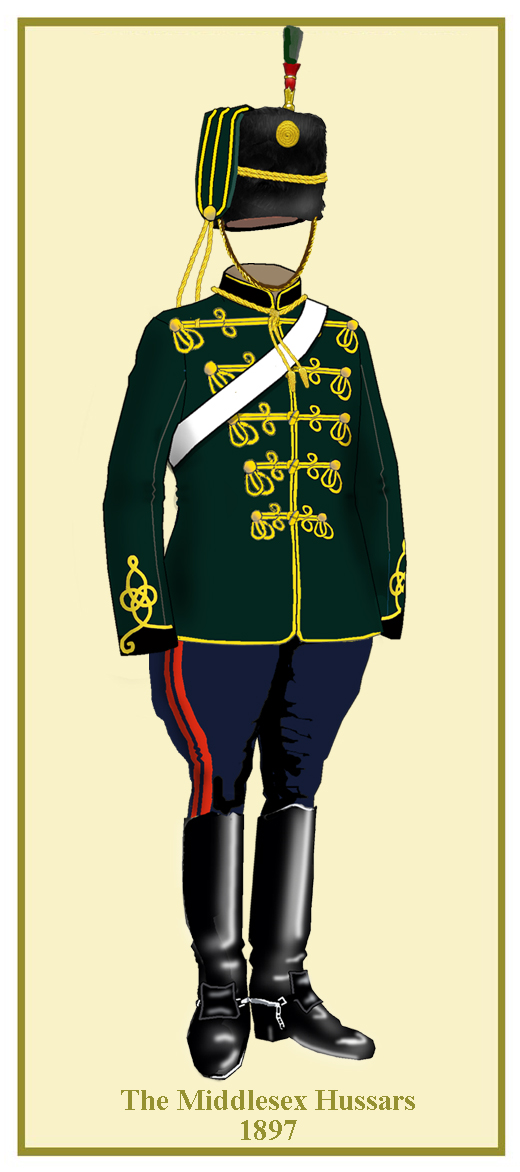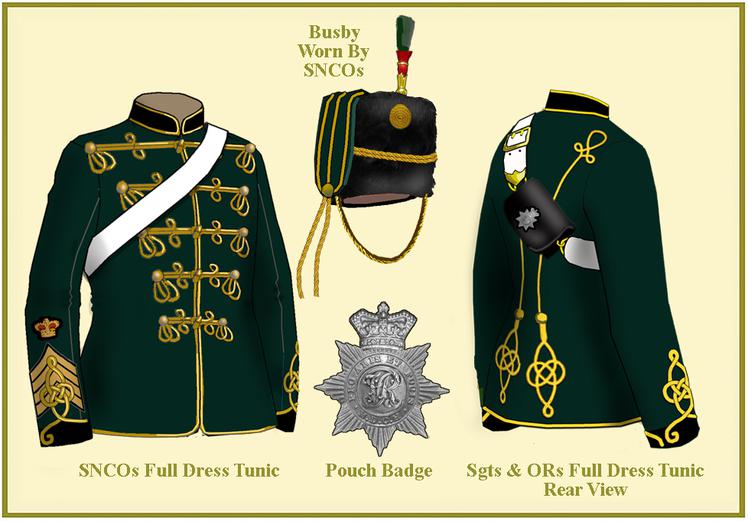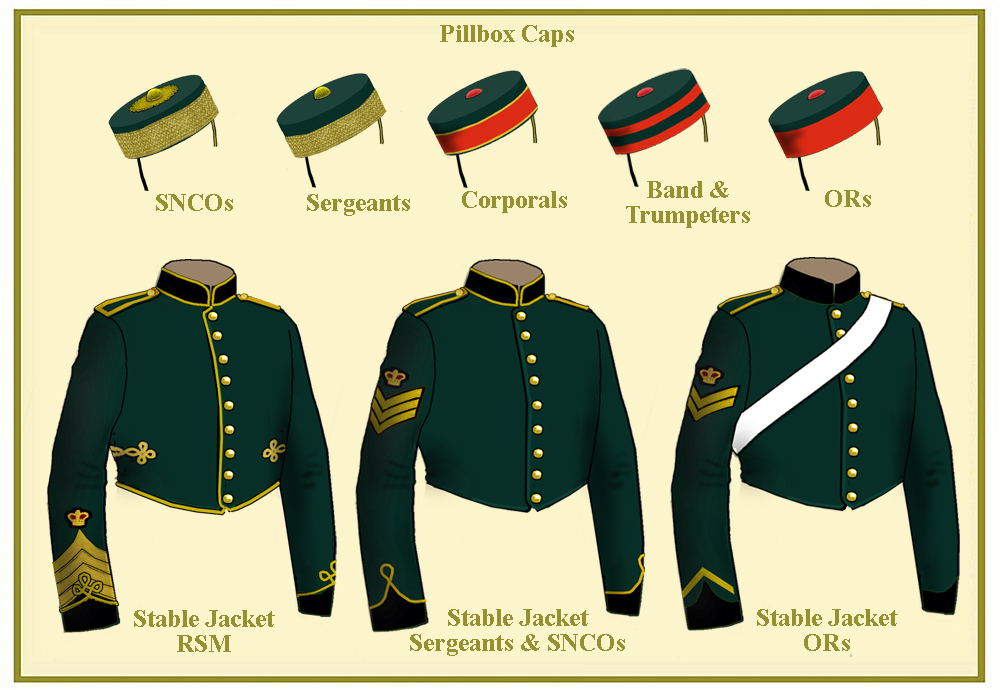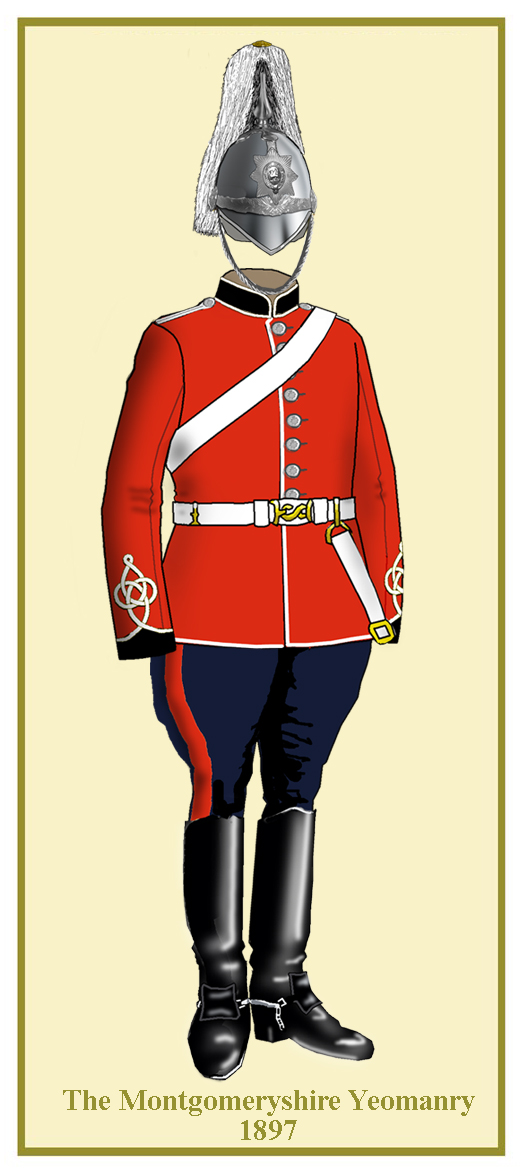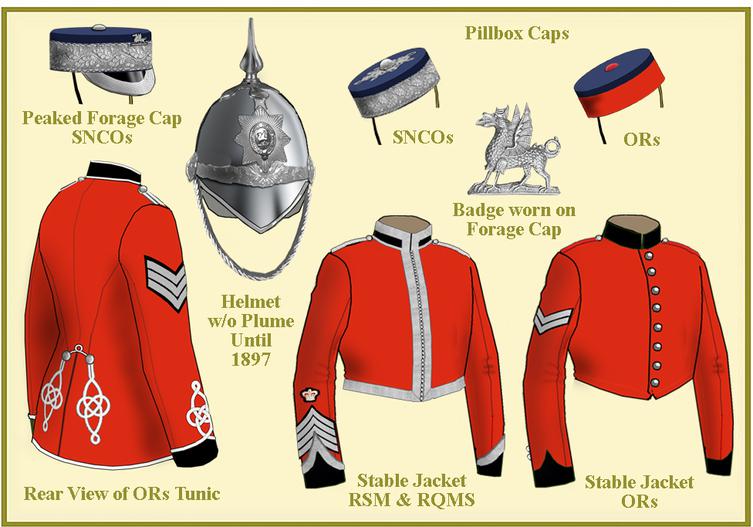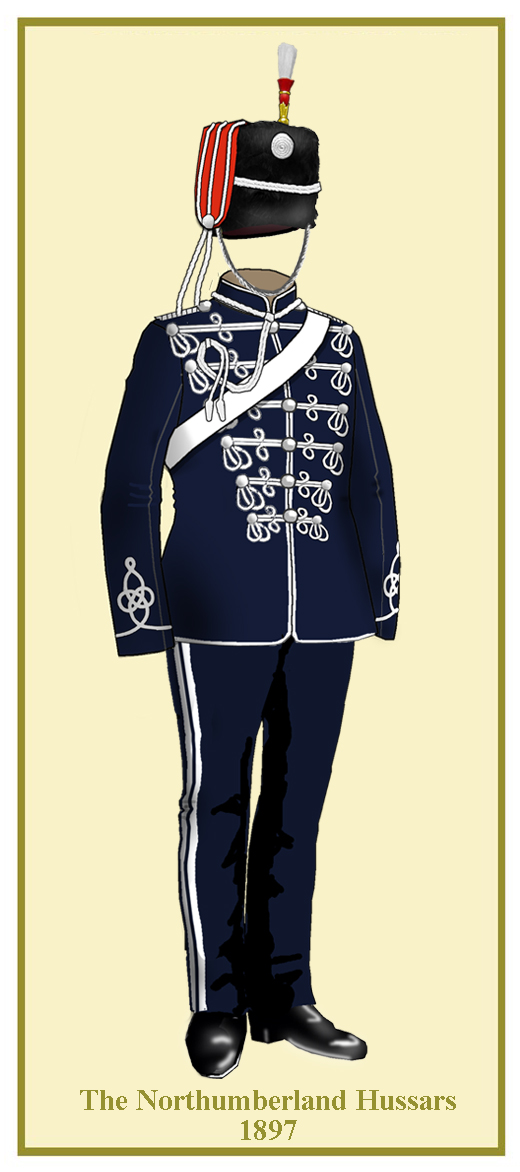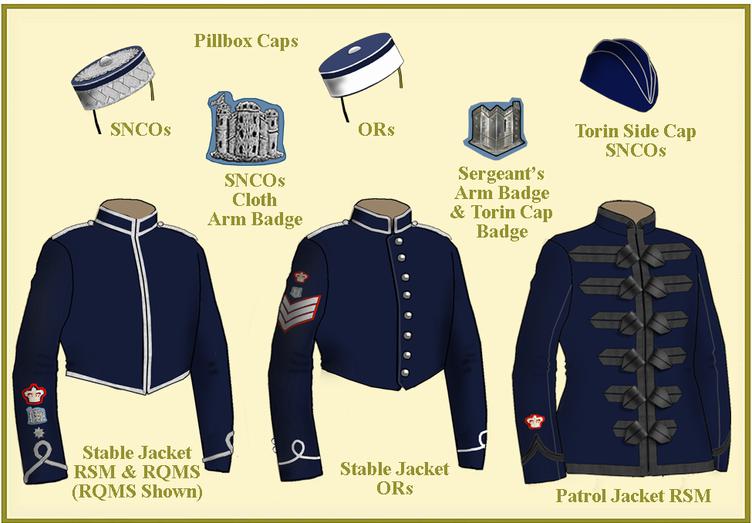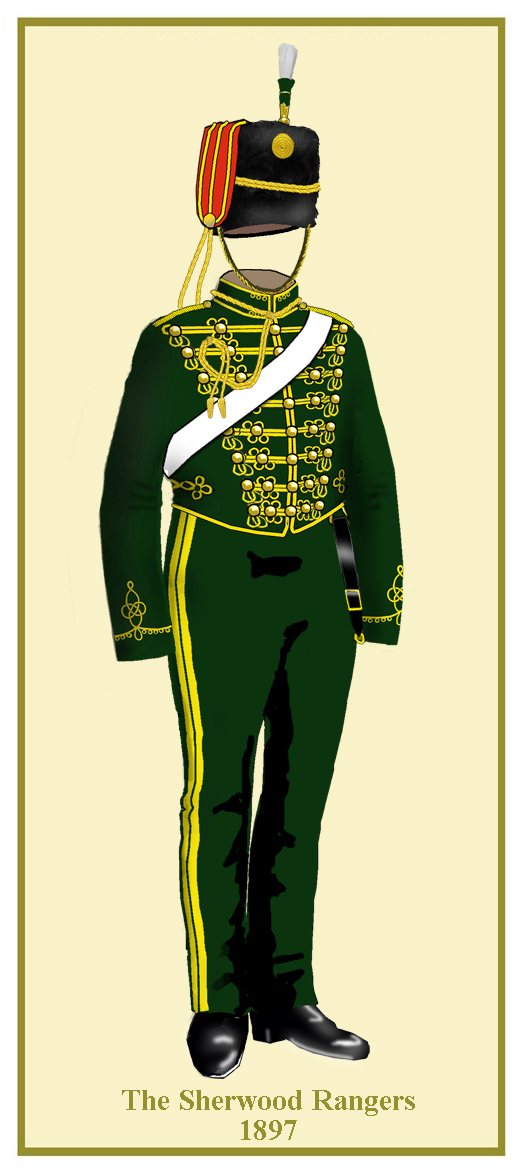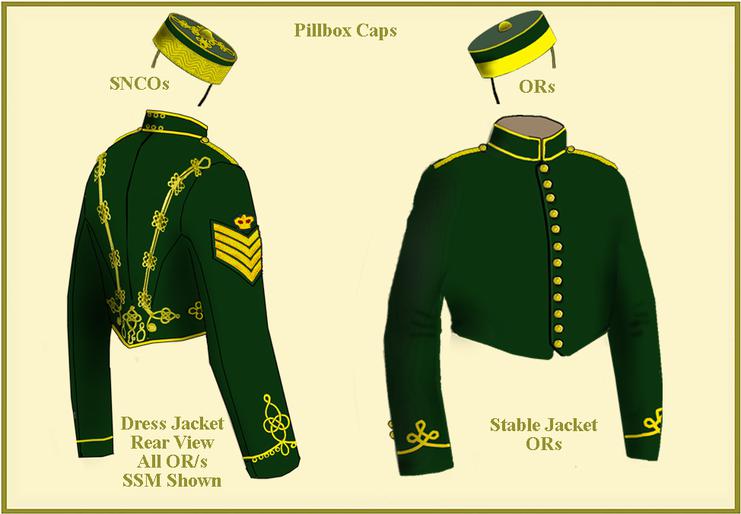The Middlesex (Duke of Cambridge's) Yeomanry
Ranked No. 27 in Yeomanry Order of preference
A troop of cavalry was raised in 1797 as the Uxbridge Volunteer Cavalry with another troop forming the following year. Both troops were apparently disbanded in 1803 and no new corps is mentioned until 1822. Unfortunately, despite mention in “The Times”, no unit was actually raised. In 1830 a new corps was formed in Uxbridge and retitled The Middlesex Yeomanry Cavalry in 1871, bearing the arms of the county on its appointments. In 1884, the Queen approved the addition of the Duke of Cambridge to the title
Formed 34th & 35th Coys of 11th Bn & 62nd Coy of 14th Bn Imperial Yeomanry in 1900
UNIFORMS OF THE BRITISH YEOMANRY REGIMENTS 1895-1900
PART 6
Uniforms
The Uxbridge Volunteer Cavalry of 1797 wore the light dragoon uniform of blue jackets, white facings and breeches with a Tarleton helmet with bearskin crest. The lace was apparently gold. The regiment newly raised as the Uxbridge Yeomanry Cavalry were dressed and accoutered as light dragoons. Unusually, the colour of the coatee was rifle green with a double row of brass buttons and shoulder scales with black facings. The dark blue trousers had a red welt. The pouch belt and waistbelt were black leather the latter with a brass plate buckle. The headdress was a black bell topped shako with a large brass Maltese cross on the front and a black horsehair drooping plume. In undress, a flat topped peakless cap was worn which was rifle green with a scarlet band. By 1856 a rifle green double breasted tunic had been taken into wear. Facings, shoulder scales and leather appointments remained the same but the trousers, still dark blue, now had double scarlet stripes. The Albert pattern helmet was the headdress which was of black felt with brass spike and black horsehair plume. The badge was a brass six pointed star surmounted by a crown. In the centre was the Royal Cypher surrounded by a garter on which was the motto “Pro Aris et Focis”.
Along with a change of command came another uniform change in 1872. The regiment now adopted the hussar style with tunic, facings and trousers of the same colour as before, although the dark green took on a distinctively bluish hue. There were three loops of yellow hussar braid on the front and the cuffs had Austrian knots with a distinctive ‘curl’ at the rear of the cuff. Shoulder cords were not worn. The 1857 pattern busby was black sealskin with dark green bag and yellow cap lines, cockade and bag lacing. The plume was green with a scarlet base. In 1882 the tunic received two additional rows of lacing and pouch belts were changed to white leather with the sword slings following suit in 1889. Blue pantaloons and V-cut knee boots came into wear about 1890. The 1887 pattern busby was replaced for some other ranks starting in 1892 but not all had been replaced by 1900. NCOs chevrons were gold on black velvet and in 1885 a crown was being worn as an arm badge by all ranks above corporal. Senior NCOs wore gold lace cap lines and cords on the busby and the tunic frogging was of gold gimp cord also. From 1884 all ranks had a white metal star with crown above on the flaps of their black leather pouches. In undress the dark green stable jacket was worn with, for privates and corporals, plain black velvet collars and cuffs with yellow edged shoulder straps. Plain gold inverted chevrons were worn by corporals and below on the right sleeve for meritorious service Sergeants had gold piping round the collar and thin loops above the cuffs, while SNCOs had gold piping all round with trefoils on the cuffs, figuring on the waist pockets and wide lace on the shoulder straps. The dark green pillbox caps for other ranks had scarlet bands and buttons while trumpeters had a ½” green stripe in the middle. Corporals had two thin lines of gold lace above and below the scarlet bands and sergeants had gold lace bands and buttons. The SNCOs had wider lace around the cap and a gold figuring on the top.
Just as the regiments volunteers were beginning to head for South Africa, orders came down for the pantaloons and overalls to be changed to dark green with double yellow stripes. Whether they were issued or not at that time is unclear. Although dark green serge frocks had replaced the stable jackets in about 1899 they appear not to have been worn until about 1902/3. After the Boer War slouch hats were worn with the green frocks and Bedford cord breeches with a scarlet stripe. A green staff pattern cap with red band and piping was also worn until 1908 after which it became green with a black band. After that year Review order was reinstated. The busby now had a red bag and the pantaloons and overalls were green with double yellow stripes. The hussar jacket also had six rows of frogging (while officers retained five). Both mounted and dismounted detachments wore this dress at the 1911 coronation.
The Montgomeryshire Yeomanry
Ranked No. 35 in Yeomanry Order of preference
A corps of cavalry and infantry styled “the Montgomeryshire Volunteer Legion” was raised in 1803. The infantry element was transferred to Militia in 1808 and the three cavalry troops became Yeomanry in 1813. They were disbanded in 1827 and along with many other corps in England & Wales reformed in 1831. Their title remained unchanged until 1920.
Formed 31st, 49th, 88th & 89th Coys of 9th Bn Imperial Yeomanry in 1900
Uniforms
The Montgomeryshire Yeomanry is one of the rare exceptions of the volunteer cavalry where the uniform colour and facings remained the same throughout its history. The Volunteer Legion’s cavalry element wore scarlet light dragoon uniforms with black facings. The chest lace and breeches were white and the Tarleton Helmet black bearskin crest, and black moleskin turban. The plume on the left was white and a white metal regimental device was worn on the right side. In 1821 the uniform became like a normal light dragoon one with double row of white metal buttons, blue trousers with wide scarlet stripes and white belts. The headdress was a bell topped black shako, a white lace band around the top with white drooping horsehair plume. On the front was a white metal star plate. When the regiment was re-raised in 1831 the coatee became single breasted and they replaced the shako with a black japanned dragoon guard helmet with black fur crest much the same as the 7th Dragoon Guards. With little change to the basic uniform, the helmet was changed to the contemporary model dragoon type with flowing horsehair plume in 1846 and the Albert pattern in 1856. Tunics were adopted in 1860 which appeared to follow the dragoon style in being single breasted but the tunic piping was white instead of facing colour and went around the skirt of the tunic along with piping around the collar and Austrian knots on the cuffs. In another unusual step, the regiment did away with the Albert Helmet in 1866 and replaced it with a hussar busby with scarlet bag and plume. It had a gilt plate on the front of the Welsh Dragon within the garter with “Montgomeryshire Yeomanry Cavalry” on the strap.
The replacement of the hussar busby by the white metal 1871 pattern dragoon helmet in 1882 has seemed to confuse military artists and uniform historians alike. The long assumption has been that shortly afterward, the uniform conformed to that of the 7th Dragoon Guards in all but the white lace instead of yellow. In fact this did not happen until long after the Boer War. The tunic remained virtually the same as the 1866 version until 1900. Apart from the white piping around the body of the garment, the double straight shoulder cords and the hussar style Austrian knots, the rear of the tunic demonstrated the hybrid nature of this uniform when it was designed. Instead of three pointed flaps, inverted Austrian knots in white lace took their place. Double loops of lace connected them to the waist buttons and then joined in a large ‘eye’ in the small of the back. The men wore blue overalls with wide scarlet stripes which, for mounted duties had been replaced with pantaloons and knee boots by 1895. White horsehair plumes were finally issued to the men (and officers) in 1896. Pouchbelts, waistbelts and swordslings had always been white and gauntlets were not worn except by officers. Rank chevrons for NCOs were silver on black velvet.
Stable jackets for other ranks including sergeants were scarlet with black pointed cuffs and collars. The RSM and RQMS wore a similar jacket to the officers with silver lace down the front and bottom. Other ranks pillboxes were blue with scarlet bands and buttons. Sergeants (including SSMs) had the same with silver band and button while the RSM and RQMS wore a peaked blue forage cap with silver lace band and a small badge above it of the Welsh Dragon in silver. Scarlet five button frocks with black collars replaced the stable jackets in 1899 and were worn for some time after the South African War. These were mostly replaced by khaki frocks with scarlet collars and trefoils on the cuffs (Why these facings were not black is a mystery). Scarlet welts were on the trousers and breeches and the slouch hat was worn as well as a plain khaki folding field cap. From 1905 a blue staff pattern cap was worn with scarlet band and piping and a white metal badge of the Welsh Dragon above a scroll bearing “MYC” on the band.
In 1908 full dress was restored and this time it was almost identical to that of the 7th Dragoon Guards except with silver/white lace and scarlet overall stripes. This was the dress worn at the 1911 coronation.
The Northumberland (Hussars) Yeomanry
Ranked No. 14 in Yeomanry Order of preference
Various volunteer cavalry units were raised in Northumberland between 1794 and 1803. Among them were the Bywell Troop, the Royal Cheviot Legion and the famous Percy Tenantry corps. They all appear to have ceased existence by 1815. In 1819 The Newcastle Regiment of Yeomanry Cavalry was raised which in the eighteen-thirties was used to quell civil disturbances. In 1876, the regiment became the Northumberland Hussars.
Formed 14th & 15th Coys of 5th Bn Imperial Yeomanry in 1900
Uniforms
The volunteer cavalry corps of Northumberland were uniformed in the normal light dragoon manner; the Bywell troop and Royal Cheviot Legion with scarlet jackets, the former with green facings and the latter with blue. Both units wore Tarleton helmets but the details of turban and plumes not clear. According to a portrait of the very young Hugh Percy, the Percy Tenantry corps wore a dark green jacket with black facings, silver (white for other ranks) edging and chest lace with white breeches and black knee boots. The Tarleton Helmet seems to have had a black turban with white or silver angled thin stripes and a black plume.
When the Northumberland and Newcastle Regiment of Yeomanry Cavalry was formed they adopted the contemporary light dragoon uniform with blue jacket, light blue collar and cuffs, plastron and trousers all lace was gold / yellow. The bell topped shako was black. In the 1830s the plastron disappeared and the overalls became dark blue with light blue stripes. In 1850 the bell topped shako was exchanged for an Albert pattern shako. In about 1856 a tunic was adopted and worn with the previous shako for some years. The tunic was double breasted with light blue collar, cuffs and piping and although the lace became silver / white the shako had gold lace fittings and lines. A dark blue kepi was taken into wear during the mid-sixties and it apparently retained the gold caplines and fittings. There are indications that a trial busby of unorthodox type was adopted by some officers in the early 1870s but other ranks appear not to have worn them.
In 1876 the regiment converted to hussars and by 1880 all ranks had been issued with the new uniforms. The conventional six-loop hussar tunic was worn with white square cord and silver ball buttons. The shoulder cords were white. Overalls had double white stripes. The 1857 pattern busby had a scarlet bag with white lace and button as did the busby boss and caplines. Unusually, the busbies of the officers continued to be decorated with gold lace, bosses and caplines. The plume was white over red.
In the late 1880s knee boots and pantaloons were introduced and by 1895 the 1857 busby had been replaced by the 1887/8 version. All equipment was white with black pouches and SNCOs had a silver crown on scarlet backing on the flap. NCOs wore silver chevrons and crowns on a scarlet backing. From 1890 an arm badge of a castle had been approved which for senior NCOs and permanent staff was of silver wire on a French Grey backing. Sergeants had a smaller metal castle (of a different design) also on a French grey backing. This badge would soon become the regimental badge. All trade and SAA badges were originally on scarlet backings but by the mid-1890s, they were on blue backings although trumpeters still retained scarlet. Bandsmen wore lyres on the right sleeve. By 1900 the Northumberland Hussars were considering changing to light blue facings (then described as French Grey).
Stable jackets followed the conventional pattern for other ranks being blue with white piping on the collar and white loops on the cuffs. Silver piping and jacket edging was worn by sergeant-majors and above with special ¾ inch lace being worn by the RSM, RQMS and other senior staff. Pillbox caps were blue with white bands and buttons for ORs and silver Austrian Wave lace for Sergeants and above. The RSM and RQMS had extra figuring on the crown. In 1898 plain blue five button frocks with breast pockets were issued and generally replaced the stable jackets. The RSM wore a special patrol jacket with six black mohair loops across the front. He appears to have been the only staff member to wear the blue silver edged Torin cap with silver badge on the left side being worn by officers in undress.
Khaki was adopted after the Boer War and worn with a slouch hat that had a French Grey puggaree. The staff pattern peaked cap taken into wear in 1902 also had a French Grey band and piping. Full dress with overalls was worn by the route lining contingent present at King George Vths coronation in 1911.
The Nottinghamshire (Sherwood Rangers) Yeomanry
Ranked No. 4 in Yeomanry Order of preference
A corps of Nottinghamshire Yeomanry Cavalry was raised in the summer of 1794 and remained in existence throughout the Napoleonic Wars. By the early 1820s there appeared to be a disconnect between the southern and northern troops. In 1828 the northern four troops were formed into a new yeomanry regiment which quickly became known as the Sherwood Forest Rangers, losing the ‘Forest’ part almost immediately. The next two decades saw them dealing with civil unrest of Reform Bill and Chartist riots before assuming the role of reserve cavalry from the 1850s to the end of the century.
Formed 10th Coy of 3rd Bn Imperial Yeomanry in 1900
Uniforms
Scarlet was the colour of the jackets worn by the Nottinghamshire Yeomanry with collar and cuffs of yellow or buff cloth. At first it was a plain coat but by 1798 it had become typically light dragoon in character with white lace across the front and similarly for the waistcoat beneath. The breeches were white for the Mansfield and Nottingham troops but blue for the Newark troop. The Tarleton helmet had a yellow turban laced silver and bore black bearskin crest. The plume on the left side was white with a scarlet base. The uniform apparently changed very little in the ensuing years but there is little pictorial evidence to either prove or disprove this. The regimental history describes a comment made at a muster in the mid-1820s that the uniforms were worn and threadbare as they had not been changed for 10 years.
The division of the county’s yeomanry came in 1828 with the northern troops amalgamated into a corps to be called the Sherwood Rangers and the other South Nottingham Corps. The suggested uniform of dark green provoked some negative comment but senior officers persisted and with the addition of yellow facings and gold lace won the day. The new uniform was of light dragoon pattern with two rows of gilt buttons, gold bullion fringed epaulettes and a black bell topped shako with white drooping plume. The brass badge was a Maltese cross. This uniform was worn until 1848 when the change was made to a hussar style with Albert pattern shako. A pre-Crimean busby was adopted in 1853 and apart from that, there was little change until 1914.
The jacket was dark green (not Rifle Green) edged all round with yellow lace. There were eight loops of hussar loops across the chest with stunted drops and double ‘eyes’ above and below the lace between the centre and end caps. The collar lace had three small eyes above and below the lace on each side of the collar and a series of eyes below the small sized Austrian knot on the cuffs. There were five rows of brass buttons down the jacket on the drops, on the eyes and in the centre. On the back there were two doubled lines of lace from the bottom edge of the jacket to the back of the shoulders ending in a large eye. Four series of eyes were grouped along the lines. In the small of the back was a large Austrian knot with figures surrounding. A crimson and yellow (gold for sergeants and above) barreled sash was worn but discontinued for corporals and privates in 1885 and for sergeants in 1892. The 1857 busby replaced the pre-Crimean one in 1868. It had a scarlet bag with yellow lace and button and a white over green plume in a brass socket along with yellow caplines looped up to the right. It is not known when the 1887 busby was adopted bit it seems to have been around 1895. Knee boots and pantaloons arrived in about 1888 and in 1882 the pouch belt was changed from black to white leather. Black leather waistbelts and swordslings continued to be worn until the end of the century. NCOs wore their gold chevrons on a dark green backing.
Stable jackets were plain dark green for privates and corporals with yellow piping on the collar and yellow trefoils on the cuffs. The RSM had a gold laced version. Pillboxes were dark green with a yellow band and button for ORs and a lace band in Austrian Wave pattern on the caps of NCOs and above. A dark green five button frock with shoulder chains was taken into wear in 1899 and worn with the pillbox on manouvres.
After the Boer War khaki frocks with green collars and green trefoils on the cuffs were taken into wear with a slouch hat with green puggaree. In 1905 a staff pattern peaked cap was authorised which was dark green with yellow band and piping. The contingent at the 1911 coronation wore the full dress uniform they had been wearing for nearly 30 years
Middlesex Yeomanry
Montgomeryshire Yeomanry
Nothumberland Hussars
Sherwood Rangers Yeomanry



